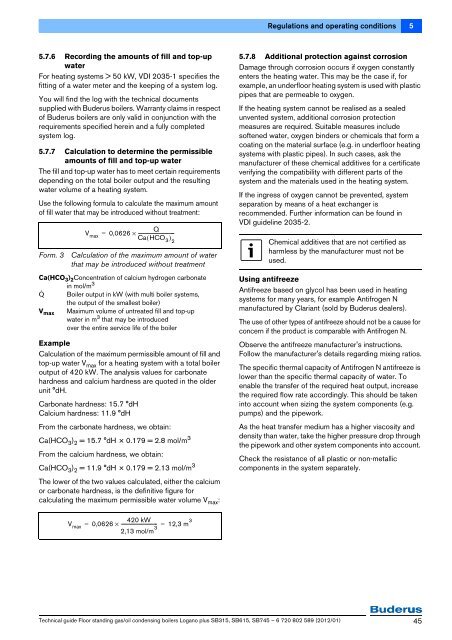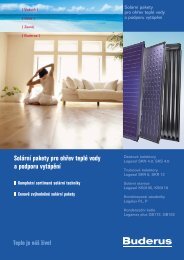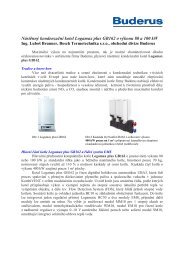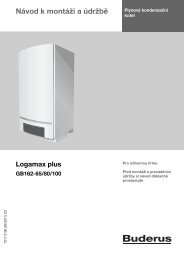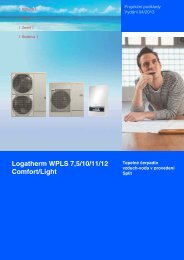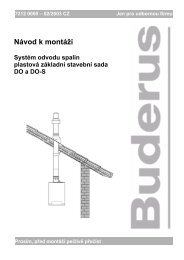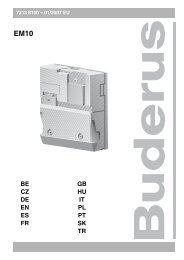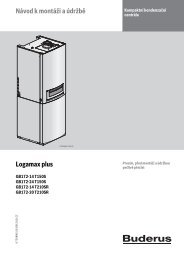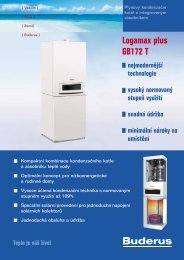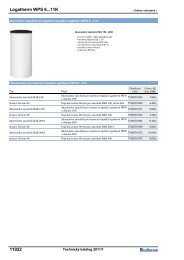Logano plus SB315, SB615, SB745 - Buderus
Logano plus SB315, SB615, SB745 - Buderus
Logano plus SB315, SB615, SB745 - Buderus
- No tags were found...
Create successful ePaper yourself
Turn your PDF publications into a flip-book with our unique Google optimized e-Paper software.
Regulations and operating conditions55.7.6 Recording the amounts of fill and top-upwaterFor heating systems > 50 kW, VDI 2035-1 specifies thefitting of a water meter and the keeping of a system log.You will find the log with the technical documentssupplied with <strong>Buderus</strong> boilers. Warranty claims in respectof <strong>Buderus</strong> boilers are only valid in conjunction with therequirements specified herein and a fully completedsystem log.5.7.7 Calculation to determine the permissibleamounts of fill and top-up waterThe fill and top-up water has to meet certain requirementsdepending on the total boiler output and the resultingwater volume of a heating system.Use the following formula to calculate the maximum amountof fill water that may be introduced without treatment:Form. 3QV max= 0,0626 × -------------------------------Ca( HCO 3) 2Calculation of the maximum amount of waterthat may be introduced without treatmentCa(HCO 3 ) 2 Concentration of calcium hydrogen carbonatein mol/m 3Q Boiler output in kW (with multi boiler systems,the output of the smallest boiler)V max Maximum volume of untreated fill and top-upwater in m 3 that may be introducedover the entire service life of the boilerExampleCalculation of the maximum permissible amount of fill andtop-up water V max for a heating system with a total boileroutput of 420 kW. The analysis values for carbonatehardness and calcium hardness are quoted in the olderunit °dH.Carbonate hardness: 15.7 °dHCalcium hardness: 11.9 °dHFrom the carbonate hardness, we obtain:Ca(HCO 3 ) 2 = 15.7 °dH × 0.179 = 2.8 mol/m 3From the calcium hardness, we obtain:Ca(HCO 3 ) 2 = 11.9 °dH × 0.179 = 2.13 mol/m 3The lower of the two values calculated, either the calciumor carbonate hardness, is the definitive figure forcalculating the maximum permissible water volume V max :5.7.8 Additional protection against corrosionDamage through corrosion occurs if oxygen constantlyenters the heating water. This may be the case if, forexample, an underfloor heating system is used with plasticpipes that are permeable to oxygen.If the heating system cannot be realised as a sealedunvented system, additional corrosion protectionmeasures are required. Suitable measures includesoftened water, oxygen binders or chemicals that form acoating on the material surface (e.g. in underfloor heatingsystems with plastic pipes). In such cases, ask themanufacturer of these chemical additives for a certificateverifying the compatibility with different parts of thesystem and the materials used in the heating system.If the ingress of oxygen cannot be prevented, systemseparation by means of a heat exchanger isrecommended. Further information can be found inVDI guideline 2035-2.Chemical additives that are not certified asharmless by the manufacturer must not beused.Using antifreezeAntifreeze based on glycol has been used in heatingsystems for many years, for example Antifrogen Nmanufactured by Clariant (sold by <strong>Buderus</strong> dealers).The use of other types of antifreeze should not be a cause forconcern if the product is comparable with Antifrogen N.Observe the antifreeze manufacturer's instructions.Follow the manufacturer's details regarding mixing ratios.The specific thermal capacity of Antifrogen N antifreeze islower than the specific thermal capacity of water. Toenable the transfer of the required heat output, increasethe required flow rate accordingly. This should be takeninto account when sizing the system components (e.g.pumps) and the pipework.As the heat transfer medium has a higher viscosity anddensity than water, take the higher pressure drop throughthe pipework and other system components into account.Check the resistance of all plastic or non-metalliccomponents in the system separately.420 kWV max= 0,0626 × -------------------------------2,13 mol/m 3 = 12,3 m 3Technical guide Floor standing gas/oil condensing boilers <strong>Logano</strong> <strong>plus</strong> <strong>SB315</strong>, <strong>SB615</strong>, <strong>SB745</strong> – 6 720 802 589 (2012/01) 45


